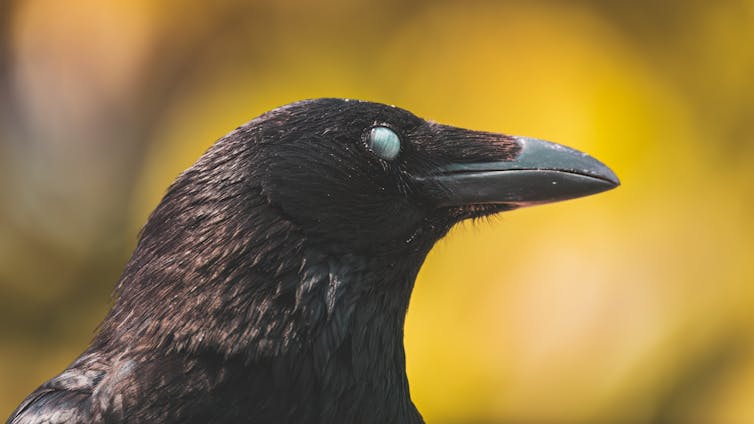Our family dog used to have a rather noticeable extra eyelid that became especially apparent when he dozed off, usually upturned on the rug. This is the fleshy curtain seen at the corner of each eye, closest to the nose. It’s also commonly called the nictitating (literally “blinking”) membrane.
You may have noticed these “third” eyelids on your pets appear occasionally, perhaps during their sleepy moments, or when they’re enjoying a bit of affection. But what does this unusual structure actually do? And why don’t we have one as well?
Third eyelids sweep in a generally horizontal direction across the eye, instead of vertically as the upper and lower lids do. They’re actually a specialised fold of the conjunctiva – the thin, moist membrane that coats the other lids and the exposed white of your eye (the sclera). They’re found in many mammalian species, but are not unique to them. Birds, reptiles, amphibians and fish can also have a third eyelid.
The structure varies too; in many species a cartilage skeleton provides support, while others contain glands that secrete tears. This variation is probably to help animals adapt to multiple different environments – to the sea, the air and even arboreal habitats in trees.
Several different studies have examined third eyelids to help understand their role in hedgehogs, kangaroos and brown bears.
And research has shown the third eyelid functions much as the upper and lower lids do. It protects the eye, and sweeps away any invading debris. It also distributes tears across the eye’s surface, keeping it moist and preventing ulcers forming. This is particularly important in brachycephalic (flat-faced) dogs, like pugs and King Charles spaniels, whose protruding eyes are not as well protected compared to other breeds.
In the wild
Both domestic and wild animals (including species from canine, feline and equine families) need eye shielding and protection from foreign bodies. Wild animals may need them even more, since they might be exploring grasslands, or contending with bites and scratches from prey or rival animals.
Preventing, trapping and removing debris is crucial for desert animals like camels, where sand and dirt might damage the eye. Their third eyelid is partially transparent and this helps camels retain some vision in the middle of a sandstorm, while covering their eyes.
In bushlands, aardvarks also have third eyelids, perhaps to protect their eyes as they root around for insects.
The third eyelid may offer protection from water, and a translucent membrane can aid underwater vision of aquatic animals, including manatees (curiously, manatees come from the order Afrotheria, which also includes aardvarks). Larger species of sharks (blues for instance) typically protect their eyes with their third eyelid when hunting and feeding.
For birds, fast air currents can prove equally damaging. So, in birds of prey like falcons, the eyelid is used during rapid flight in hunting. Often air gusts will set off third eyelid blinking in these birds (including owls) as a natural protective reflex.

In other avian species, it might protect against damage from sharp-beaked offspring. Imagine a bird returning with a prize of food to a nestful of voraciously hungry chicks, all pecking and scrabbling to get their share.
Studies suggest third eyelids play a unique role in woodpeckers, whose skulls undergo vibration trauma when drilling a tree trunk with their beak. Two problems arise as a result of this forceful head banging – damage to the softer eye tissue, and sawdust being thrown into them. In this case, the third eyelid may act as both a seatbelt and a visor.
In polar regions, where the white landscape reflects sunlight, ultraviolet rays can damage the eye. This can lead to temporary loss of vision – a condition known as snow blindness. So it’s possible that some arctic animals like polar bears have third eyelids that absorb UV light. There’s no established evidence of this yet, but their third eyelids are clear, assisting them in being skilled marine hunters.
Evolutionary loss
Humans and most primates (except lemurs and the calabar angwantibo, from the Lorisidae family) have evolved to the point where a proper third eyelid is no longer needed. Human and primate eyes are less likely to be damaged by hunting, rivalry and the environment. Plus, human eyes are highly sensitive and able to recognise and respond to danger by closing more quickly.
But the third eyelid isn’t entirely gone. Humans have a remnant of it called the plica semilunaris. This crescent-moon fold can be seen at the corner of our eyes too. Have a look yourself in the mirror.
Some scientists have argued the plica can still help drain tears. There are two small ducts at the angle of our eyelids, which allow excess and old tears to escape into the nasal cavity. That explains why you get a runny nose when you cry.
But would getting our true third eyelid back be of any use to us? Maybe the alien in Men in Black could offer an opinion. Perhaps it could allow us to naturally keep our eyes cleaner, less irritated, or dislodge that contact lens that won’t come out.
We’ll just have to accept we don’t share the clever nature of our pets’ third eyelids. But then we also can’t compete with their night vision, acute hearing or sense of smell. It’s a long list.![]()
Dan Baumgardt, Senior Lecturer, School of Physiology, Pharmacology and Neuroscience, University of Bristol
This article is republished from The Conversation under a Creative Commons license. Read the original article.
Source Link: Why So Many Animals Have A Third Eyelid, Including Our Pets – Yet Humans Don’t